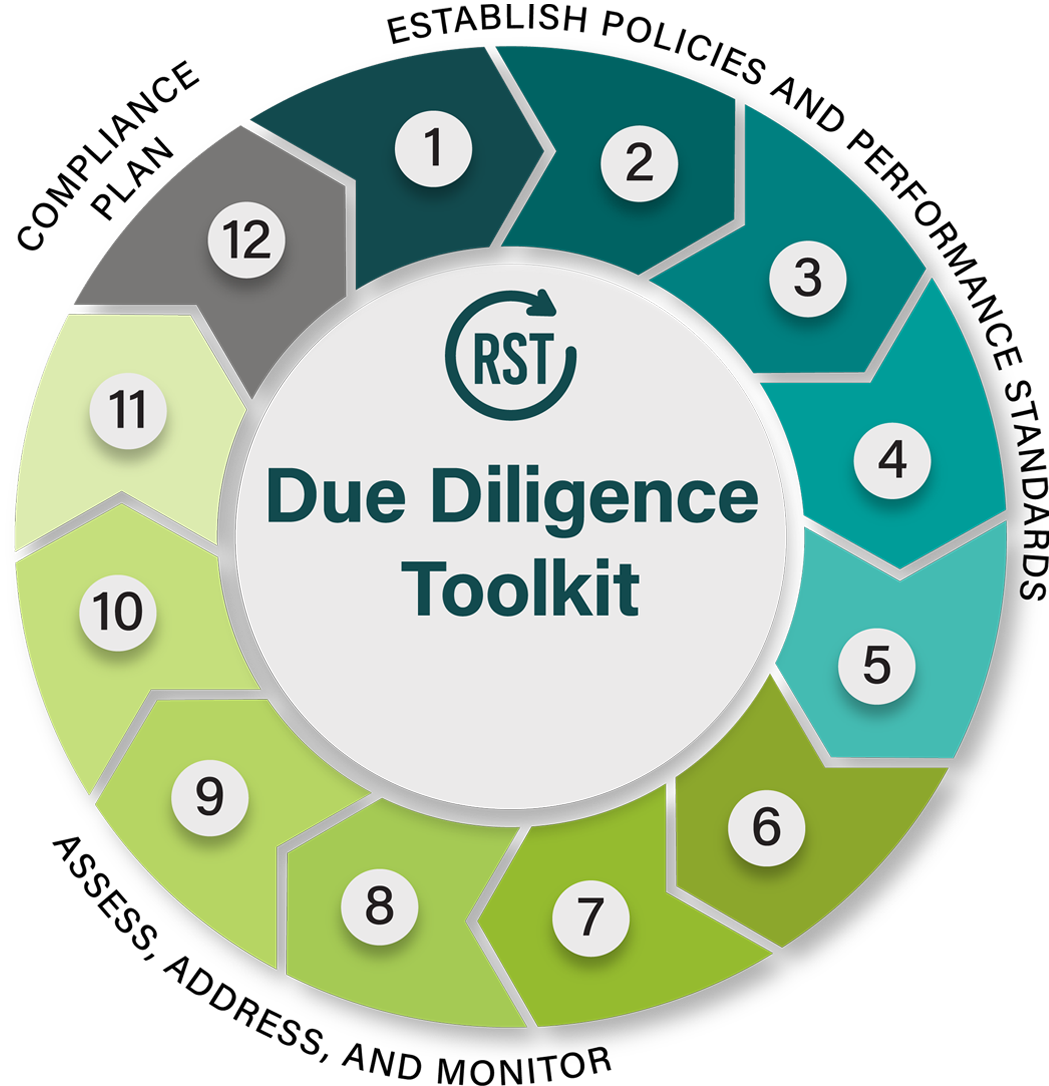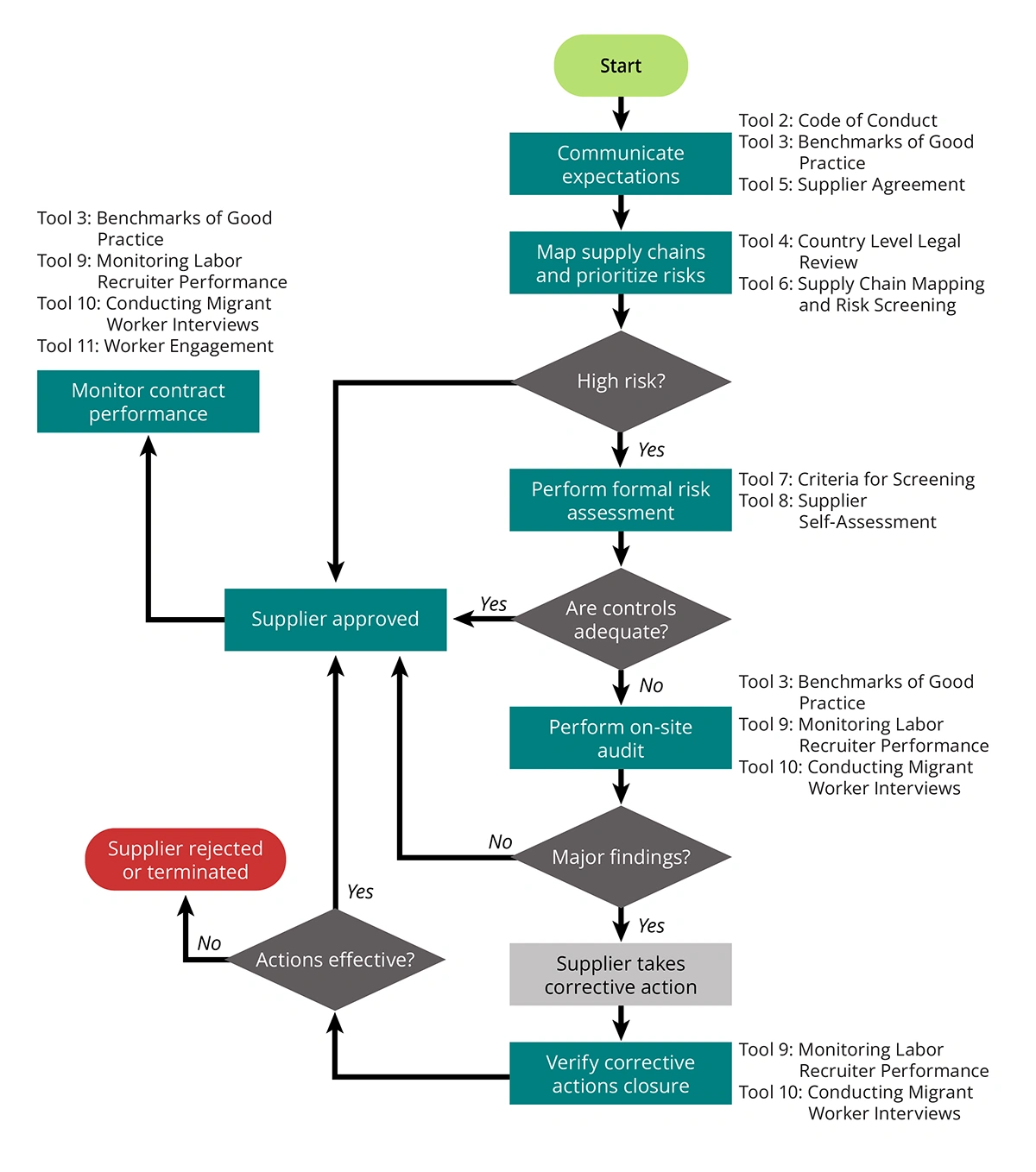Base Toolset
Prevent and Address Forced Labor in Your Company’s Supply Chains
Base Toolset Overview
The 12 human rights due diligence tools in the RST toolkit are designed to help private sector companies, their suppliers, federal procurement professionals and federal contractors identify, prevent, and address forced labor risks and situations in their own operations and supply chains. The toolset aligns with the UN Guiding Principles on Business and Human Rights, and the OECD Due Diligence Guidance for Responsible Business Conduct.
Click on the Sector button in the center of the Toolkit graphic, or the below menu, to find stand-alone toolsets that are closely modeled on the Base Tool but have included special considerations for select high-risk sectors.

This tool provides an overview of the processes a company could implement to a) identify potential risks of human trafficking within its supply chains; b) evaluate and prioritize identified risks; c) implement enduring solutions; and d) monitor supplier performance over time. It is the fundamental systems approach to due diligence described by the UN Guiding Principles on Business and Human Rights and the OECD Due Diligence Guidance for Responsible Business Conduct.
A supply chain Code of Conduct establishes basic performance expectations for subcontractors, suppliers, and agents. It is important that your company sourcing policy or Code of Conduct explicitly prohibit human trafficking in all its forms and set out protections for workers. The sample provisions can be used by any company, including federal contractors and their subcontractors, as they consider how best to create, strengthen, or revise their own supply chain policies.
Benchmarks of good practice are the detailed performance standards for a company’s Code of Conduct. They further clarify requirements for business partners and can be used to monitor the labor and human rights performance of suppliers, subcontractors, and labor agents. The set of sample benchmarks is consistent with the sample Code of Conduct provisions listed in Tool 2, however they are not intended to ensure compliance with specific legal requirements, such as Federal Acquisition Regulation (FAR): Combating Trafficking in Persons.
Understanding the legal frameworks and policies that govern the prevention of human trafficking can help companies assess which source countries in their supply chains may have a heightened risk of trafficking and can provide insight into the types of issues that may arise at worksites in those countries.
The purpose of a “Social Responsibility Agreement” is to formally acknowledge that the subcontractor, supplier, or agent has read and agrees with the company’s supplier Code of Conduct requirements and commits to conform with them. It can be a standalone document or included as an appendix to a contract. Contract terms and conditions covering the obligations of both the buyer and supplier are the legally enforceable requirements for suppliers to prevent human trafficking, including forced labor.
Supply chain mapping allows a company to trace the chain of custody — and points of accountability — at all levels of production, from extraction or procurement of raw materials to processing, manufacturing, packaging, and distribution to final sale. The supply chain for each product — including miners, growers, processors, manufacturers, suppliers, logistics providers, vendors, agents, and traders — will be unique, so supply chain mapping should be conducted on a product-by-product or service basis.
The risks of human trafficking can be mitigated by properly designed and implemented processes for recruitment, selection, and hiring of workers. Those risks are greater and more difficult to control when recruitment, selection, and hiring are outsourced to third-party labor recruiters. Therefore, companies should, whenever possible, recruit, hire, and employ workers directly.
When direct recruitment is not possible, companies must exercise careful due diligence in the screening and selection of labor recruiters to minimize the risk of human trafficking as a result of fraudulent or misleading recruitment practices.
An important part of a due diligence process to prevent human trafficking and other supply chain social responsibility issues is to assess current and prospective suppliers for potential risks. This sample self-assessment tool can help identify potential human trafficking risks in how a subcontractor or supplier recruits, selects, and hires workers, the supplier’s relationship with labor brokers, and how migrant workers are managed.
When direct recruitment is not possible, companies must exercise careful due diligence in the selection of labor recruiters to minimize the risk of human trafficking as a result of fraudulent or misleading recruitment practices (refer to Tool 7, Criteria for Screening and Evaluating Labor Recruitment Candidates). Once a company has engaged a labor recruiter, regular monitoring of the recruiter’s performance against the company’s Code of Conduct and legal requirements is essential to help ensure ongoing compliance.
Migrants are a particularly vulnerable class of workers due to their non-resident, often contingent, status. They are frequently insecure socially and economically, likely do not speak the local language, may lack the social and legal protection local workers hold, and may be in a situation of forced labor due to unethical recruitment and employment practices such as indebtedness or lack of access to their identity documents. This tool provides a set of sample interview questions to use when conducting targeted interviews of migrant workers and other employees provided by labor recruiters and labor contractors.
The ability for workers to gain awareness of and advocate for their rights, discuss workplace issues of concern and interest, have channels for individual and collective advocacy, and communicate grievances is essential for the preventing, mitigating, and remediating of human trafficking, including forced labor. When workers know their rights and are able to participate in safe forms of workplace dialogue — both as individuals and collectively — they are better positioned to protect themselves against coercion, deception, discrimination, and other forms of exploitation.
This tool is specifically intended for use by companies that need to demonstrate compliance with the requirements of the Federal Acquisition Regulation (FAR): Combating Trafficking in Persons and submit certification 52.222-56 set forward by 52.222-50(h) and 22.1703(c).
Supply Chain Due Diligence Process
Base Toolset
Establish Policies and Performance Standards
Assess, Address, and Monitor
Compliance Plan
Dive deeper into forced labor case studies, compliance, and more in our Resource Library.

